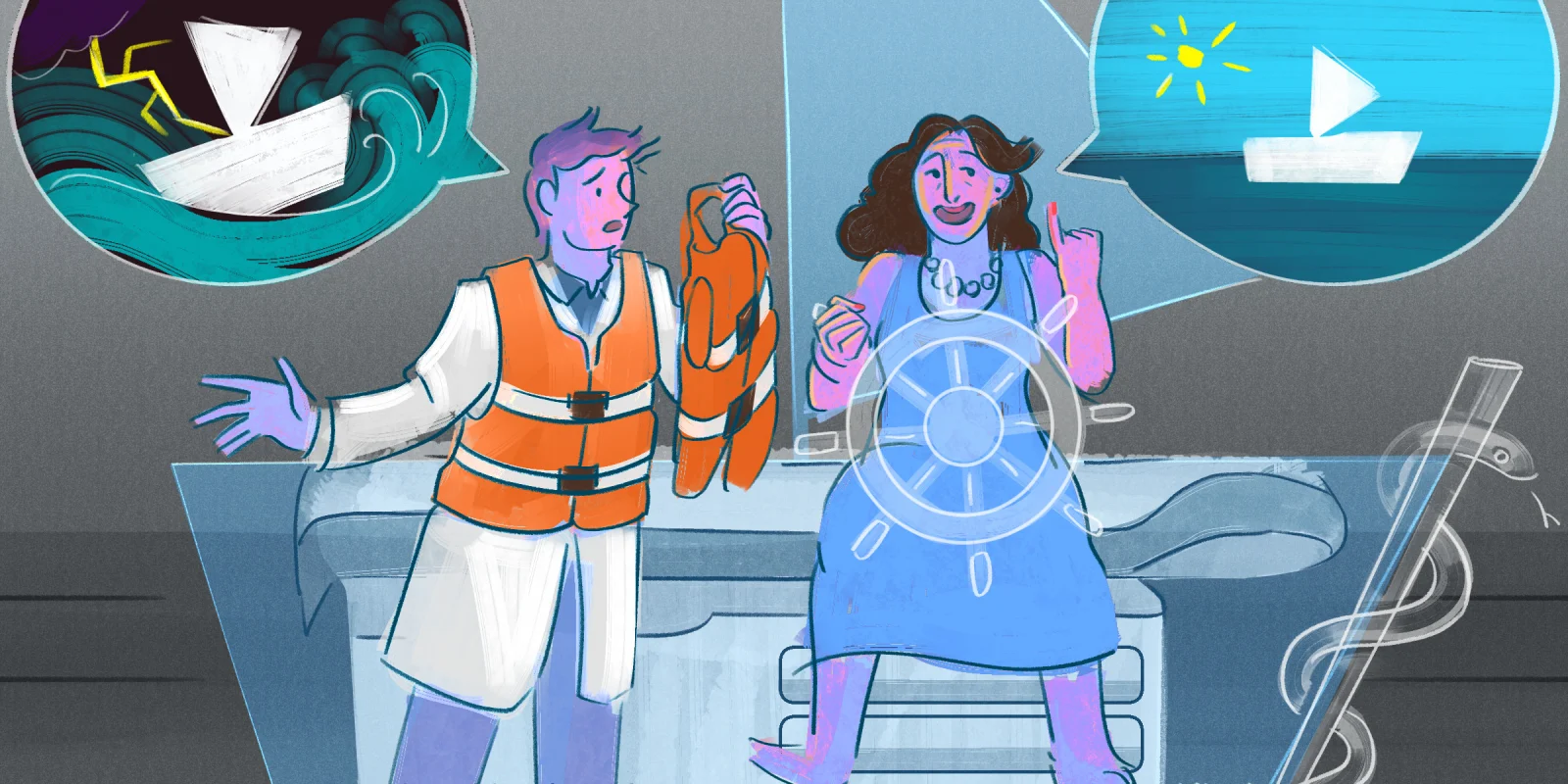“If my baby’s meant to die, then that’s what God would want.”
“I understand,” I told the young woman, the new mom, the little girl whom I could once make smile by blowing a glove into a balloon and drawing two eyes above its thumb-shaped nose. “Unfortunately, it’s not as simple as that.”
“I don’t want my baby sliced open. That’s about as simple as a thing can get.”
“I understand,” I repeated myself, my finger twisting circles inside the phone cord’s spiral coil.
“And I bet this won’t be the last one. More doctors. More surgeries. More phone calls like this one after more ultrasounds, more pokes, more tests.”
“I understand,” I said again. My eyes fell to my prescription pad, my pen motionless upon it, the exam table and its paper covering, another veneer over all that’s meant to be unwavering and true.
“And what if I said yes? What if the surgery works? Will my baby be normal then?”
The sound of the clock’s tick-tick-ticking on the wall, spinning circles like the spiral coils around my finger. I felt like a frightened worm now, my only dream to burrow away and hide, just escape.
“Transposition is associated with other non-cardiac issues,” I told her. “Cognitive deficits. Speech delays. Hyperactivity issues. Maybe seizures.”
I heard the echo of my own voice through the receiver’s plastic, embarrassed at how the words must have sounded beyond the coils and wires on their other, frightened end. Her baby was 10 days old. This new mom was just a little girl herself, and was only now finding her voice, her strength. And me? I was hiding behind jargon like cognitive deficits and speech delays. Sometimes we doctors hide behind the technical words to keep us separate, we who heal and they who must be fixed.
I waited within the silence. The smell of iodine and impotence all around. The room was getting hotter. I wrestled with a growing discomfort in my stiff and starchy coat.
“Well,” she said slowly. “That’s no life we want for our baby.” And then a shift, a crack, through which I — not the doctor, but the man — might wiggle through. “If it was your baby … ” she began.
I flashed back to residency, or, more specifically, Children's Hospital Oakland, an elective rotation I’d been allowed to create in the months before my graduation. My family medicine program had prepared me well for all of the things I would face in practice — except the kids that were really sick. And so, I hoped to quell my own anxieties by driving the hour south to Childrens’ to work from 6 p.m. to 4 a.m. in an effort to gather as much experience as I could. I still remember the faces of those parents, masks of exhaustion like painted smiles on sad clowns. The status epilepticus kids. The quadrapalegic kids with their contractures. The shells of life like hollow ghosts, their parents hovering with all their love. Wiping drool from their faces. Kissing their cheeks without smiles. Their sacrifice and love so enormous they couldn’t imagine their lives any other way.
I stared at my finger inside the phone’s coils. The ticking louder, slower. The smell of iodine now gone. In its place, the stench of something left out too long and turned to rot. I didn’t share with her my truth. That maybe she was right. That maybe this little girl was stronger than this man inside this room, this little boy with his stiff white coat.
“Unfortunately,” I circled back, feeling less like a doctor than a clown, “it’s not as simple as that. There are some laws — they’re known as ‘Baby Doe Rules’ — that really don’t give you, the parent, any choice.” I was referring, of course, to the 1980s regulations that prohibit clinicians from withholding life-saving medical care from a newborn no matter what the parents’ wishes might be. I heard my voice trailing off in the hollow emptiness, like the hope-drained eyes of all those kids.
It didn’t matter what she wanted. It didn’t matter what I thought, about the wasted lives, the hollow ghosts. For this new mom and her new baby, there was a law. A law that would save him.
A law that flattened the slippery slope, smoothing its extreme ends. A law that washed away the gray and left only black and white.
I’d encountered the law for the first time 18 years ago. One would hope that so many years later I would have learned to better navigate the shades of gray by now. But I haven’t. Certainly not with Tiggy, a 60-something-year-old Native Hawaiian I met two years back, her heart so full of aloha I fell in love with her on that first day.
When I met her, Tiggy’s carcinoembryonic antigen, or CEA, was only half-a-point above normal, but the CT showed something suspicious and the scope confirmed it. A cecal mass the size of those Scantron bubbles we used to pencil in, the ones that earned us the MDs behind our names. I sent her to one surgeon and then another. Tiggy wasn’t happy with what either of them had to say.
“Why would they want to take out half my colon for something this small?” Tiggy questioned, wagging her pinky finger in the space between us.
I narrowed my focus to the polished nail on her pinky, tip vibrant and luminous in the drab and dull room. Fire engine red like the glossy skin of a Porsche, it had a rhinestone glued to its center, with flares of pink and purple like a Starburst set on fire.
“I think you should get the surgery,” I told her.
“What if I go the natural route first?” she asked. “I found a clinic in California that uses plant-based foods, mistletoe, ozone; they send the tissue off to a lab in Greece to see what herbs will work.”
I understood what she was trying to do. But I didn’t agree. So I told her — not too much to steal her hope but enough to let her know she mattered. That it would be a shame if the mass grew, that if she waited too long she might need chemo and the surgery she was trying to avoid anyway. Or worse.
“I can’t sign up to have half my colon removed for a spot smaller than my pinky nail,” Tiggy told me, her fingernails like five ballerinas on pointe atop the table’s paper veneer.
It was the same the next time, and the time after, and all the times after that. Her CEA bumping up another half point at a time, the CTs that showed the mass a millimeter bigger, then two.
“Wouldn’t it be terrible,” I confided, “if one day we look back on today and wish we’d have pulled the trigger sooner? Back when all you needed was one surgery for it to be gone?”
But the patients are the drivers. And we put the passengers in starchy coats. And so now, I speak my piece, push as hard as I feel I can, and back off when I feel them pushing too hard back. “At least take this prescription for trimethoprim in case the clay doesn’t work,” I say. “How about one or two DTaP’s instead of all five, or a single MMR instead of two?”
What’s a country doc to do? You can lead a fish to water, but you can’t teach a horse to fish. Or however the saying goes. I’ll be the first to admit it: Sometimes I get it wrong. I imagine we all do. And, ultimately, who is to say whose truth is more true?
“Just promise me you’ll come back,” I told Tiggy every time. “Check the numbers in three more months. If the CEA goes up next time, or the mass doesn’t go away, at least consider surgery? Before we don’t have any choice?”
In this divided world of magnified polarities, in which relative truths are fed to us by algorithms generated by secret machines, we doctors, we pillars, we elders must make a choice. The grays are gone and only white or black are left. In this new world, perhaps it’s more important to nurture the relationships we have than to push those who don’t agree away. Or maybe not. Maybe it’s better to stake the boundaries around our truths with glaring markers, risk everything we have by pushing them harder.
Tiggy came back last week. She was in pain. She couldn’t eat. She’d spent the last night retching, had lost six pounds in just under a week.
You all know how this ends.
I looked at her nails as I pushed down into her abdomen, the exam table’s paper crinkling as I probed. They were pink. Like a kid’s fluff of cotton candy atop a cardboard stick. A mass the size of a cantaloupe, the sweeping hand of time tick-tick-ticking on the wall.
I read the discharge summary a few days later. They’d taken her to surgery. Anastomosed a bypass tract between her small and large intestines to move past the obstruction. But they’d left the cancer alone. It was too big to resect. Even chemo wasn’t an option anymore.
And there, the cutting edge that bleeds through each day. The hundred decisions we make. The lives we touch. The ones we save. The ones we lose. And all the words spilled between. How hard do we push? And what to do when they push back?
There are no Baby Doe laws for grown-ups. If there were, there’d be no controversy. No more requests for mask exemptions or back-and-forths about vaccines. Ivermectin would still just be for scabies; hydroxychloroquine just another rheumatoid drug with tons of side effects, and something about the eyes.
I couldn’t change Tiggy’s mind, even if I’d pushed harder. But at least she knew I cared. At least she knew my truth.
And that’s why I’m OK with how things turned out. I have to be. And maybe that’s my message to you, too: Push as much as you can until they hear and know your truth. Toss your truths like lifelines off the bow into the storm and the thrashing sea. Convince them of how much you care. Show them how sad you’ll be if they don’t grab on, if they let themselves drift away.
It’s not an easy fit, sometimes, these coats, this role, this life. Too starchy. Too hurried. Too white. But I’m pretty sure they still stand for something proud, something noble. And, besides, they’re the only coats we got.
Have you ever pushed a patient too hard? Not hard enough? Share what happened in the comments.
Steve Rogoff, MD is a rural family practice, emergency, and functional medicine physician who lives in Hawaii. His interests include surfing, music, and playing with words. His writing can be found at www.steverogoff.com. Steve is a 2021–2022 Doximity Op-Med Fellow.
All names and identifying information have been modified to protect patient privacy.
Illustration by April Brust







